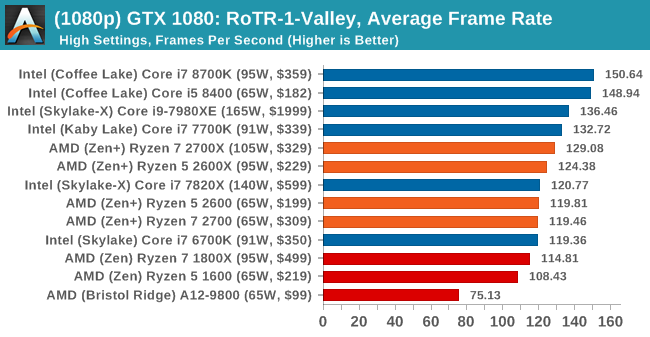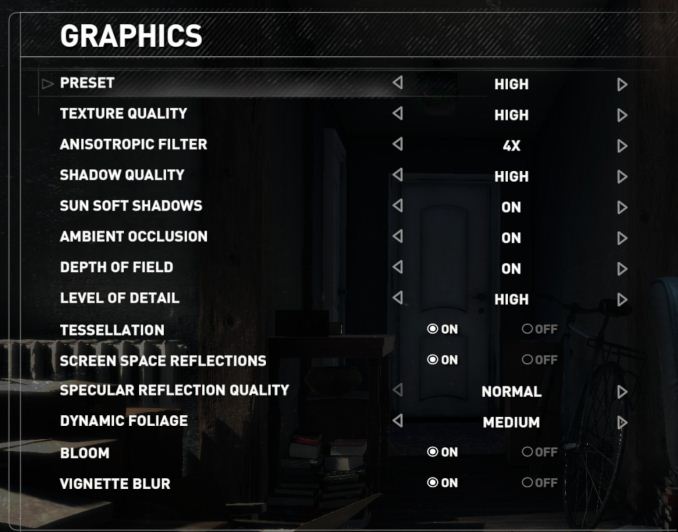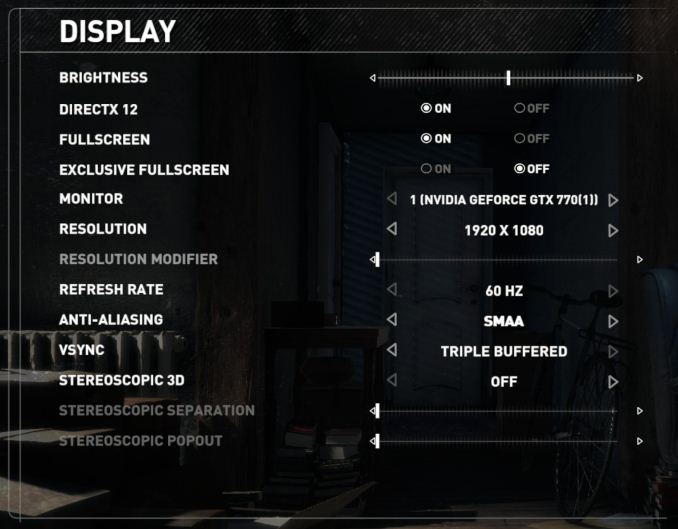The AMD 2nd Gen Ryzen Deep Dive: The 2700X, 2700, 2600X, and 2600 Tested
by Ian Cutress on April 19, 2018 9:00 AM ESTRise of the Tomb Raider
One of the newest games in the gaming benchmark suite is Rise of the Tomb Raider (RoTR), developed by Crystal Dynamics, and the sequel to the popular Tomb Raider which was loved for its automated benchmark mode. But don’t let that fool you: the benchmark mode in RoTR is very much different this time around.
Visually, the previous Tomb Raider pushed realism to the limits with features such as TressFX, and the new RoTR goes one stage further when it comes to graphics fidelity. This leads to an interesting set of requirements in hardware: some sections of the game are typically GPU limited, whereas others with a lot of long-range physics can be CPU limited, depending on how the driver can translate the DirectX 12 workload.
Where the old game had one benchmark scene, the new game has three different scenes with different requirements: Geothermal Valley (1-Valley), Prophet’s Tomb (2-Prophet) and Spine of the Mountain (3-Mountain) - and we test all three. These are three scenes designed to be taken from the game, but it has been noted that scenes like 2-Prophet shown in the benchmark can be the most CPU limited elements of that entire level, and the scene shown is only a small portion of that level. Because of this, we report the results for each scene on each graphics card separately.
Graphics options for RoTR are similar to other games in this type, offering some presets or allowing the user to configure texture quality, anisotropic filter levels, shadow quality, soft shadows, occlusion, depth of field, tessellation, reflections, foliage, bloom, and features like PureHair which updates on TressFX in the previous game.
Again, we test at 1920x1080 and 4K using our native 4K displays. At 1080p we run the High preset, while at 4K we use the Medium preset which still takes a sizable hit in frame rate.
It is worth noting that RoTR is a little different to our other benchmarks in that it keeps its graphics settings in the registry rather than a standard ini file, and unlike the previous TR game the benchmark cannot be called from the command-line. Nonetheless we scripted around these issues to automate the benchmark four times and parse the results. From the frame time data, we report the averages, 99th percentiles, and our time under analysis.
All of our benchmark results can also be found in our benchmark engine, Bench.
1080p



4K

















545 Comments
View All Comments
peevee - Thursday, April 26, 2018 - link
I mean, Octane test in Chrome is what V8 javascript compiler does. And it itself is build with MSVC AFAIR.Dragonstongue - Thursday, April 26, 2018 - link
just looking back at this, you say according to title 2700x-2700-2600x-2600 and yet in most tests are only listing the results for 2700x-2600x..not good for someone really wanting to see the differences in power use or performance comparing them head to head sort of speak.seems the 2700 would be a "good choice" as according to the little bit of info given about it, it ends up using less power than the 2600 even though rated same TDP with 2 extra core 4 extra threads O.O
I do "hope" the sellers such as amazon at least for us Canadian folk stick closer to the price they should be vs tacking on $15-$25 or more compared to MSRP pricing, seems if one bought them same day of launch pricing was right where it should be.
1600 has bounced around a little bit whereas 1600x is actually a fair price compared to what it was "very tempting" though the lack of a boxed cooler is not good.....shame 2600 only comes with wraith stealth instead of spire seeing as the price is SOOO close (not to mention at least launch price vs what the 1xxx generation is NOW, AMD should have been extra nice and bundled the wraith spire for 2600-2600x and wraith LED and wraith max or whatever for the 2700-2700x
I would imagine if they decide to do a 4 core 8 thread 2xxx that would be the spot to use the wraith spire (less heat load via less cores type deal)
29a - Thursday, April 26, 2018 - link
Not trying to be sarcastic but will this article be finished? I really wanted to read the storage and chipset info. If the article is as complete as it is going to get please let us know, 20 year reader asking.John_M - Saturday, April 28, 2018 - link
I'm sure it will be finished one day but I agree that it doesn't seem so at the moment. If you want to find out about StoreMI AMD has a page about it: https://www.amd.com/en/technologies/store-miET - Tuesday, May 1, 2018 - link
I think we've got ourselves a race: which will get here first, the missing parts of the 2nd gen Ryzen review, or new Raven Ridge drivers? Or perhaps hell will freeze first.29a - Friday, May 4, 2018 - link
Sadly it appears as though the article will not be finished. This site was great during about its first 15 years of existence, Purch has done a thorough job of purching it up.jor5 - Tuesday, May 8, 2018 - link
Oh dear what an embarrassing end to this article.Tuck it away under "what was I thinking??" and pretend it never happened.
x0fff8 - Wednesday, May 9, 2018 - link
is this article ever gonna get updated with the new benchmarks?MDD1963 - Thursday, May 10, 2018 - link
And just like that, my 7700K is fast again! :)peevee - Thursday, May 10, 2018 - link
"Technically the details of the chipset are also covered by the April 19th embargo, so we cannot mention exactly what makes them different to the X370 platform until then"That was written for the article published April 19th, and as of May 10th STILL in the text.